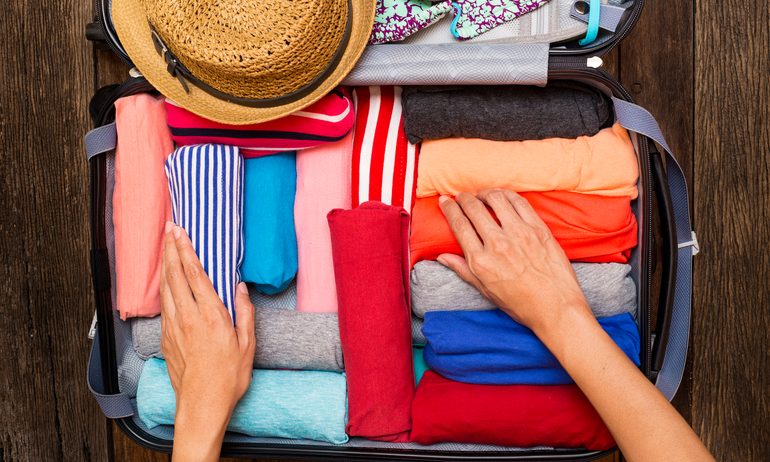5 Tips to Succeed at Carry-On Only Travel
If you can fit it all into your carry-on, you'll avoid checked bag fees and other inconveniences.

Many or all of the products on this page are from partners who compensate us when you click to or take an action on their website, but this does not influence our evaluations or ratings. Our opinions are our own.
Carry-on only travel might sound intimidating at first glance, but there are a number of benefits to traveling without checked luggage. Just think: You can save on airline baggage fees, skip the baggage claim and enjoy a more stress-free flying experience.
Here's how to travel with only carry-on luggage, plus more advice on ways to avoid checking bags.
» Learn more: Airline credit cards that offer free checked bags
Carry-on only travel tips
1. Bring both a carry-on bag and a personal item, when allowed
The number of bags you can carry onboard and the size and weight allowed vary. Factors typically depend on the airline you’re flying, the class of service you’re in (including if you’re flying a more-restrictive basic economy fare) and whether you have an airline credit card or elite status.
Check your airline’s website to see the carry-on policy for your flight. There’s a good chance you can bring both a carry-on bag and a personal item like a bookbag, laptop or purse that fits under the seat in front you. If that’s the case, bring both items and pack both with everything you’ll need for your trip.
NerdWallet has outlined the best luggage, backpacks and other packing gear that are great for carry-on travel in its Travel Gift Guide.
2. Buy needed items at your destination
If you’re going on a long trip or you typically overpack, it may seem impossible to fit everything you need into carry-on luggage. And you may be right. One trick is to rely on the fact that almost everywhere you go will have stores — buy items you need while you're on the trip itself.
Shopping at your destination is particularly helpful for goods that you won’t need to bring back with you, like sunscreen, shaving cream and shampoo.
That tip somewhat mirrors the 10-$10 rule, which is a packing strategy where — if you can acquire the item upon arrival in less than 10 minutes for less than $10 — you should just buy it there.
If you don’t feel like heading to a shop when you land, check with your hotel to see if they offer any of these items for free or if you can purchase them from the hotel itself.

3. Wear your bulkiest shoes on the plane
Maximize the space in your carry-on bag by wearing your bulkiest shoes on your flight. This leaves more room in your carry-on for clothes, toiletries and other necessities.
If you prefer not to fly while wearing boots or heavy shoes, wear them onto the plane and bring warm socks, slippers or flip-flops to swap into before takeoff or mid-flight.
4. Look for accommodations with laundry services
Rather than pack fresh clothes for each day you’ll be gone, look for accommodations that come with laundry facilities, like an Airbnb or a hotel that offers laundry services to guests. This way, even if you'll be gone for few weeks, you can get away with packing enough clothes for just four or five days.
» Learn more: 4 benefits of working remotely from an Airbnb
5. Roll your clothes
A great way to save space in your carry-on luggage is to roll your clothes instead of folding them. This might not work for bulky items like heavy sweaters or jackets, but it’s great for packing underwear, T-shirts, pajamas and shorts.
Know which items are only allowed to fly in carry-on
And then there are the items that can only travel in carry-on anyway. Yes, certain relatively-common objects are actually not allowed to even go in checked luggage.
In contrast from the TSA carry-on restrictions that require objects like pocket knives and liquids more than 3.4 ounces to remain in checked luggage if you must fly with them, the Federal Aviation Administration has rules stating that certain items are prohibited from flying in checked luggage.
Common items that the FAA prohibits in checked baggage include:
Lithium batteries.
Electronic cigarettes.
Cordless curling irons that contain a gas cartridge or that are butane fueled.
Fuel cells containing flammable gases or water-reactive material.
Matches.
Certain medical device that contain radioactive materials such as heart pacemakers
Among the most notable of those items not to overlook? Lithium batteries. Whether you're traveling with a drone, flying with a mobility scooter or even flying with certain laptops, you might unknowingly have a lithium battery with you. Lithium batteries may seem harmless but can pose threats including explosions when exposed to extreme temperature or pressure conditions.
Check with the FAA, but the items in the bulleted list above can generally fly in carry-on baggage, just not checked baggage.
» Learn more: Which airlines have the best (and worst) fees?
Ditch the giant suitcase
Carry-on only travel frees you from the hassle and expense of lugging big suitcases, but it takes planning. Check your airline website to learn baggage allowances, try to find accommodations with laundry facilities or services, then pack only what you need as tightly and efficiently as possible.
With these tips in mind, you'll be more likely to successfully evade unnecessary airline bag fees.
How to maximize your rewards
You want a travel credit card that prioritizes what’s important to you. Here are some of the best travel credit cards of 2025:
Flexibility, point transfers and a large bonus: Chase Sapphire Preferred® Card
No annual fee: Wells Fargo Autograph® Card
Flat-rate travel rewards: Capital One Venture Rewards Credit Card
Bonus travel rewards and high-end perks: Chase Sapphire Reserve®
Luxury perks: The Platinum Card® from American Express
Business travelers: Ink Business Preferred® Credit Card
Chase Sapphire Preferred® Card
Travel
Dining
🔥 Huge highest-ever bonus on NerdWallet's 2025 Best All-Purpose Travel Rewards Card is back. Don't miss your rare chance to: Earn 100,000 points when you spend $5,000 on purchases in the first three months. That's worth at least $1,250 toward travel booked through Chase.



